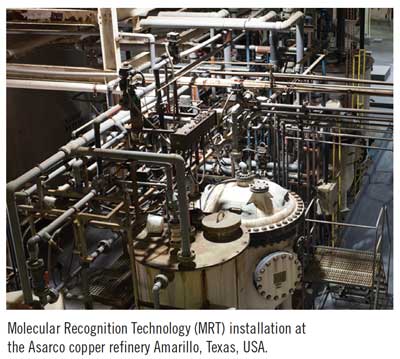Ucore Rare Metals Inc. recently issued an update on preparations for its SuperLig-One rare-earth separation pilot plant.
 Approximately 40 metric tons of material sourced from the company’s flagship Bokan-Dotson Ridge property in southeast Alaska was processed at Tomra Systems ASA, Koblenz, Germany, utilizing DEXRT ore sorting technology. The process resulted in approximately 19 mt of sorted rare earth-bearing material. Ucore said the Tomra work represents the first step in the company’s process flowsheet: delivering upgraded material that is consistent with prior test work, eliminating approximately 52% of the feed as waste while retaining 96% of the rare-earth oxides.
Approximately 40 metric tons of material sourced from the company’s flagship Bokan-Dotson Ridge property in southeast Alaska was processed at Tomra Systems ASA, Koblenz, Germany, utilizing DEXRT ore sorting technology. The process resulted in approximately 19 mt of sorted rare earth-bearing material. Ucore said the Tomra work represents the first step in the company’s process flowsheet: delivering upgraded material that is consistent with prior test work, eliminating approximately 52% of the feed as waste while retaining 96% of the rare-earth oxides.
A 3-mt bulk sample was split from the sorted material and shipped to SGS Lakefield Research Ltd., Lakefield, Ontario, Canada, where SGS will utilize the circuit developed for Ucore’s Preliminary Economic Assessment, which includes crushing, grinding and magnetic separation, followed by a nitric acid leach, to yield approximately 500 gallons of pregnant leach solution. In addition to delivering a PLS suitable for separation in the SuperLig-One pilot facility, Ucore said the SGS work will provide further independent confirmation of the process flowsheet set out in the PEA.
In an earlier press release, Ucore explained that, in preparation for the MRT testing process, non-REEs including Al, Fe, Th, Ti, and Zr are first removed from the Bokan PLS by precipitation at controlled pH levels. Removal by pH-controlled precipitation results in cost savings and a reduction in the number of MRT SuperLig resin columns used in the process. More than 99% of the REEs remain in solution along with non-target elements including Cu, Ni, Zn, Co and Mn. This output solution is then fed into the first SuperLig column designed to selectively remove these non-target elements. The rare-earth metals, as a group, are then selectively removed from the resulting raffinate through binding onto an additional SuperLig column. These bound elements are then eluted into solution as essentially a pure mixed rare-earth concentrate.
The SuperLig-One facility, currently under construction near Salt Lake City, Utah, USA, is expected to be completed and ready for initial fluid testing in March. The plant was designed for the purpose of testing the use of Molecular Recognition Technology (MRT) for the separation of rare earth elements at bulk scale. Upon receipt from SGS, the Bokan PLS will undergo an initial test run at the Utah facility followed by a production run commencing before the end of Q1 2016. The initial output product from the SuperLig-One pilot program will be critical heavy rare-earth elements (often referred to as H-CREO’s) in the form of metal carbonates of dysprosium (Dy), terbium (Tb) and europium (Eu), scheduled for delivery in Q2 2016.
Ucore said the initial test phase of the SuperLig-One facility has been engineered to accept REE feedstock from the Bokan project. Subject to modifications at the pre-processing stage, the pilot plant’s modular design can be reconfigured to accept feedstock from alternative sources of rare earths and other metal feedstocks from potential sources worldwide.
The plant is being built by IBC Advanced Technologies, which specializes in developing innovative selective separation solutions based on MRT products. IBC claims a customer list of resource companies using its proprietary products and processes that includes Tanaka Kikinzoku K.K. (Japan), Asarco Grupo Mexico, Impala Platinum Ltd. and Sino Platinum (China). MRT is a branch of Supramolecular chemistry, originally pioneered by Charles Pedersen at E.I. DuPont Laboratories in the 1960’s. That original research into the capabilities of MRT for selective binding of metal ions culminated in the awarding of the Nobel Prize for Chemistry to three researchers in the development of the technology in 1987.









